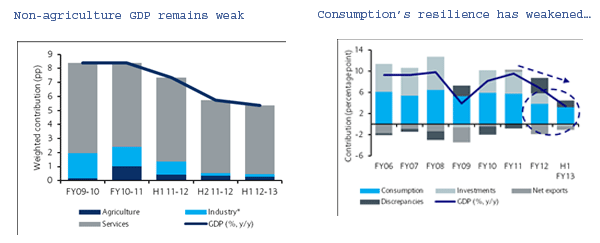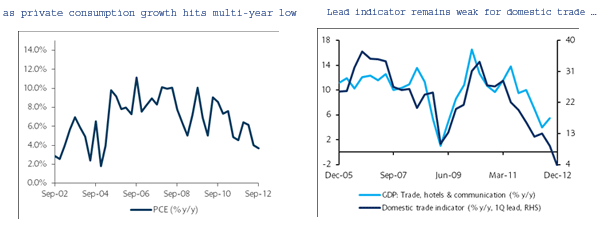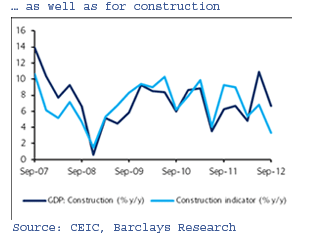India's Q3 GDP grew 5.3% y/y, a tad better than our expectation (5.0%) but in line with the consensus (5.3%). This follows the previous quarter’s 5.5% y/y growth and leads to average real GDP growth of 5.4% during Q1-Q3 2012. While the headline print was somewhat better than our forecast, we do not consider the outcome as indicating strength in overall economic activities in the coming quarters.
Some of the points that stand out in the current release are:
- Consumption demand remains weak – private final consumption expenditure grew 3.7% y/y in Q3 (averaging ~4.6% in Q1-Q3 2012), markedly lower than the average of ~7.6% during the previous five years.
We do not anticipate any meaningful turnaround in economic momentum in near future. However, given the benefit of a markedly favourable base, the y/y growth numbers will likely remain supported. The trend in industrial growth, which have fallen sharply – average of ~1% in Sep 11-Mar 12 from ~5% in Apr 11-Sep 11 – will remain a key indicator to watch in this context. In sum, while weakness in the resilient segments such as consumption and domestic trade suggests continued sluggishness in overall economic activity, we do not view the risks to our FY 12-13 growth forecast of 5.8% as sizeable (say, beyond 20-30bp downside).



Weak 3Q print should not alter the RBI’s stance; we still expect 50bp of rate cuts in Q1 2013
While this latest GDP print was a modest upside surprise versus our expectation, the overall trend in growth remains weak. For instance, growth in last three quarters has slowed to an average of 5.4%, a far cry from the 8.0% growth in same period last year. The continued slowdown in growth has considerably increased the pressure on the central bank for further monetary easing. However, the Reserve Bank of India (RBI) remains uncomfortable with the level of inflation and inflation expectations. The RBI is attempting to strike a balance by holding rates steady, while ensuring that the pressure on liquidity in the banking system does not become disruptive. Unless we see meaningful downside surprises to inflation (headline or internals) in mid-December, we expect the RBI to maintain its policy stance in its December meeting. Supportive measures (CRR cuts or OMOs) will likely continue from the RBI in the near term to prevent any further worsening of the liquidity deficit. We expect repo rate cuts to start next year and are forecasting 50bp of cuts in the repo rate in Q1 2013 and a cumulative 100bp by mid-2013.
(Siddhartha Sanyal, Rahul Bajoria & Kumar Rachapudi are research analysts with Barclays Capital)







